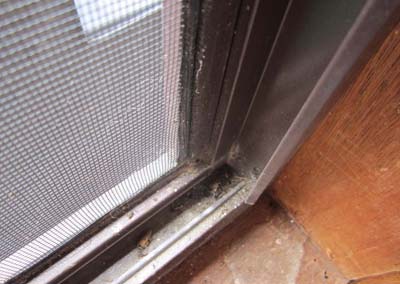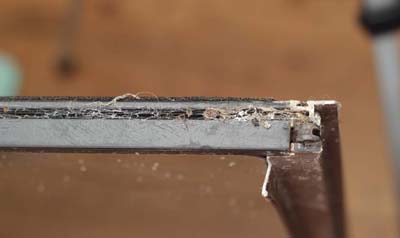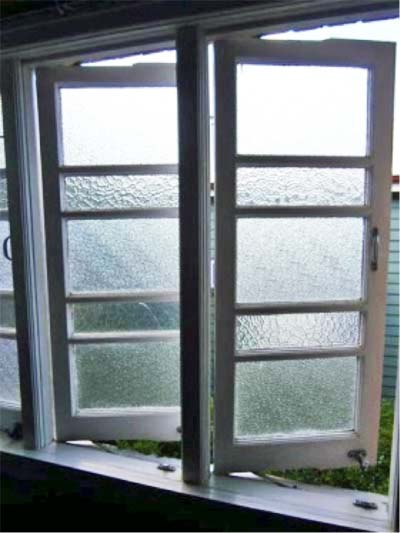This article describes how to maintain various types of windows around the home.
The most common problems with windows are paint build up on timber windows and dirty or clogged hinges and rollers. Another problem with timber windows is that the wood will swell in moist conditions. When it has been raining for a couple of days timber windows and doors often tend to stick.
The best time to do the maintenance on windows and doors that have swollen due to moisture absorption is when the weather has been wet. Then you can plane and sand your windows knowing that they will work the next time it rains a lot.
When sanding and planing windows, make sure that you leave a gap of 3mm all the way around the window. This will allow for paint and some movement.
Casement widows
Casement windows have what is known as a “sliding hinge”, which consists of a metal track with a metal guide sliding within it. This is usually at the base of the window frame. This slide clogs with dust and dirt over time. The easiest way to clean the sliding hinge is to spray a small amount of WD40 into the track and open and close the window repeatedly until it comes free. Sometimes you will need to use a small screw driver to get into the track and scrape out the dirt build-up. With older timber casement windows the hinges may have been covered in paint. Where the paint build up is more than 1mm you will need to remove it.
With timber casement windows, where the panels open and close onto each other, there is something called a “rebate”. This rebate tends to fill up with paint. If you need to plane the paint because it is so thick, make sure that you plane the window on the inside of the rebate. It may be a lot easier to plane the outside of the rebate, however this rebate forms the weather seal when the window is closed.

Dirty aluminium window track

Dirty window slider
Awning windows
Awning windows can be maintained using the same techniques as used for casement windows.
Sash windows
Not staying open is the main problem that occurs with sash windows
This is caused by a broken “sash balance”. The sash balance is the mechanism that holds open the window. The most common type of sash balance is a spring loaded tube which is screwed to the top of the window frame and the underside of the window leaf. When you replace these make sure that you prop the window open, unscrew from the bottom of the window leaf first and then remove it from the window frame. Use a pair of pliers to hold the screw plate that is under the window leaf, do not use your fingers (if the balance has tension in it and slips from your fingers it will unwind very quickly cutting your fingers. Lastly when you install the new sash balance make sure you follow the tensioning process mentioned in the manufactures instructions, again use pliers for the tensioning because new balances spin much faster and quicker than old ones.
Timber double hung windows that are sticking will most likely have paint build up in the window frame. You need to sand inside the window frame as well as the window to rectify this problem. A multi tool that has sander attachment will make the sanding process much easier. If windows have been painted shut, then run a craft knife or razor blade to break the seal, and then sand or plane.
Old “sticky” aluminium double hung windows tend to bind because the leaf guides (generally a brush strip or similar) have worn out. These are very easy to replace, simply slide one out and take it your local hardware store or window manufacturer and they will be able to supply you with new ones.
Sliding windows
Timber sliding windows are not very common. You are more likely to find them as a sliding door. The maintenance is the same for both. If you find them sticking, it maybe paint build up inside the frame, usually at the top of the window. The other alternative is that the rollers may be broken. If the problem is paint build up, simply do the same as a double hung window, where you will need to sand the inside of the frame as well as the window or door.
Whether the sliding window is made of timber or aluminium, the rollers are all very similar. First you need to check and clean out the tracks at the bottom and then check that the rollers are not broken by lifting the window out. If the rollers are broken, replacement rollers are available from your hardware store or window manufacture. These are usually held in place by a screw through the ends of the window frame. If your rollers are in good condition it is best to use a graphite powder as the lubricant to free the rollers. Graphite is a dry lubricant and will not attract dirt and clog up the wheels.
These tips were shared with you by Matt Shutkowski creator and author of HowTodecks.com.au. Matt is an Australian builder with over 12 years experience.







